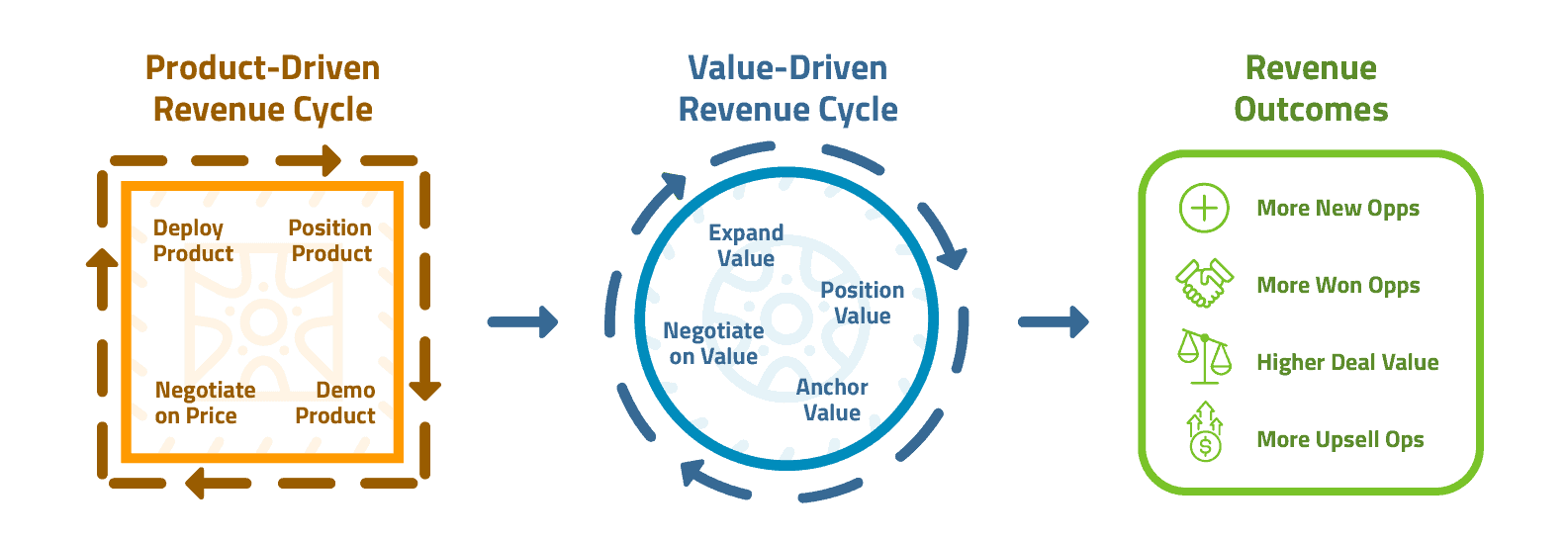Most sales and marketing teams spend too much time leading with their product and product functionality. Product pitching typically causes buyer disengagement. A few years back Forrester found that 80% of executives believe meetings with sellers are a waste of time and three-quarters said sellers are “not knowledgeable about their business” or “their specific business issues.”
The better alternative to leading with product is leading with buyer value. This means starting each buyer interaction confirming and re-confirming our buyer’s goals, pains, desired improvements and payoffs, and committing to this approach throughout the buying cycle. Pivoting from product to buyer value moves us from a “defensive posture” of having to defend and explain our product to an “offensive posture” of leveraging a buyer’s goals, struggles, and pains to create buying momentum. Bottom line, you will always score more points on offense than defense.

Leading with Value Discovery
Leading with our product typically involves just one level of buyer discovery. We present our product and ask if there is interest in purchasing. Leading with buyer value, by contrast, involves three levels of value discovery. We want to find a critical goal, identify a gap to goal resolution, and confirm payoffs to solving the gap and achieving the goal:
- Critical Goal: All selling starts with a buyer goal to move from a current state to a preferred ideal state. Buyer improvement goals become more critical when they are: named in a business plan or roadmap; a priority for a CEO, VP, or executive team; or have a specific target improvement.
- Gap to Goal Resolution: Buying momentum increases with a known gap or known pain to achieving the buyer’s goal and a buyer’s belief that a vendor has a product or product capability that resolves this gap to move more quickly toward a desired ideal state.
- Buyer Payoffs: Any purchase requires a buyer and their organization make changes to behaviors and processes, and pay for this privilege. So, there has to be a clear payoff or clear win for the buyer. This could be aligning to a critical goal, a compelling ROI case, or removing a risk.
Before and After: Two Companies Who Made the Shift
Here are two examples from companies in very different industries on how they moved from buyer conversations focused on product to buyer conversations focused on value.
 Enterprise provider of data, analytics, and decision support to insurance providers |
Leading with Product Discovery:
Leading with Value Discovery:
|
|
Growth stage provider of conversation AI to colleges in support of student success |
Leading with Product Discovery:
Leading with Value Discovery:
|
How Leading with Value Drives Revenue Growth
Leading buyer conversations around value rather than product significantly increases revenue production across the entire buyer life cycle.
- More New Opps: New prospects engage more often when they are invited into a value-added conversation about their goals and gaps versus being overwhelmed with feature and product dumps or with a high volume of content marketing.
- More Won Opps: Buyer conversations that lead to a buyer payoff around an identified buyer goal which can be easily recapped throughout the entire sales process progress and close at a much higher rate than conversations focused on product.
- Higher Deal Values: When we establish buyer value early in the sales process and anchor this value in a payoff statement, negotiations focus a lot less on price concessions.
- More Upsell Opps: When we establish one or more important buyer goal as part of a selling cycle that leads to a closed/won opportunity, it is a lot easier to subsequently introduce a second product or solution by linking back to these goals.
Assessing Your Value-Selling Readiness: A Simple Self-Diagnostic
Here are a few questions you can ask yourself as you think about making the transition from product-driven to value-driven buyer discovery and engagement:
- Have you developed clear buyer use cases aligned to known market challenges?
- Have you identified buyer impacts that are measurable? Are they specific enough to build a payoff statement and increase momentum around the case for purchasing?
- Have you developed discovery questions to support your prospectors, sales teams, and customer success teams in qualifying buyers around their goals, gap to goal resolution, and target payoffs?
Shifting from a product-driven revenue cycle to a value-driven revenue cycle isn’t always intuitive or easy for sales and prospecting teams, but armed with the right materials and a value-oriented mindset, your team can make the shift, jump start growth and accelerate the revenue cycle.
